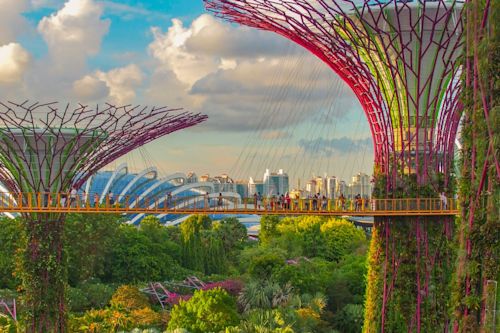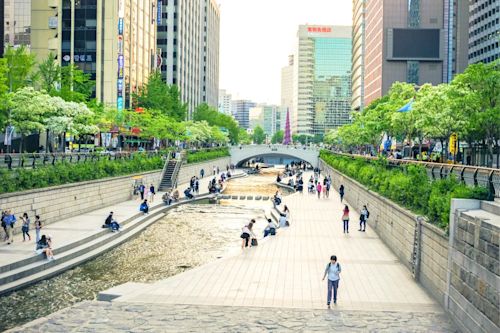Smart Underground Access Lessons from Montreal and Singapore
Is the future of urban development underground? Cities aiming to position themselves as global benchmarks in this century have long been exploring subterranean infrastructures to strengthen resilience, sustainability, and equitable growth. Rising housing density, climate pressures, and limited natural resources are degrading urban environments and forcing planners to look for solutions beneath the surface.
Beyond offering shelter from extreme weather and housing transport networks or parking facilities, underground development also presents opportunities to reduce energy demand, such as through geothermal solutions. At the same time, it can free up land above ground for green areas and affordable housing, with an emphasis on pedestrian-friendly planning.
Whether for public or private use, major cities already demonstrate that underground space can accommodate new infrastructure efficiently. In Montreal, more than 30 kilometers of tunnels connect offices, shopping centers, and public transit. Meanwhile, Singapore’s Jurong Rock Caverns store millions of cubic meters of hydrocarbons deep below Jurong Island.
This is how both cities have embraced the underground as a key element of their urban development strategies.
Montreal’s Underground City: Life at Minus 30 Degrees Celsius

Montreal’s underground city is the true nervous system of a vibrant metropolis that refuses to be paralyzed by its extreme winters, when temperatures can drop below –30°C.
Stretching across 33 kilometers of interconnected corridors, this subterranean network covers 12 sq. km and brings together 1,200 offices, 2,000 shops, more than 200 restaurants, 40 banks, 40 cinemas, seven hotels, and four universities.
To connect these spaces, it integrates 10 metro stations, two train stations, and two bus terminals. Far more than an urban convenience, Montreal’s underground node stimulates economic growth, enhances pedestrian safety, and fosters community life—all while offering a refuge from the city’s harsh climate.
La Réso: Managing Safety and Smart Access in a Closed Space
Known locally as "La Réso", Montreal’s underground city must sustainably handle the daily movement of more than 500,000 people—around 183 million every year. This is the core challenge of a system that blends public complexes and private areas, while still navigating how to balance inclusive access with smooth transitions to outdoor spaces.
To achieve this, innovative security solutions are essential. The goal is to maintain both fluidity and public trust in an enclosed environment by creating a resilient system against physical and digital threats. Intelligent access technologies, including RFID and facial recognition, play a central role.
Cameras with advanced sensors monitor not only crowd flows but also smoke, fire, abandoned objects, and even sudden changes in temperature. Data is processed in a control center capable of issuing early warnings for rapid evacuation or facility shutdown if required.
Connectivity and privacy are safeguarded through a secure infrastructure that uses VPNs, encryption, and centralized management by the City Council. This network coordinates transportation, security, and maintenance across multiple checkpoints, reinforced with multi-layer authentication and IoT devices to control entries and exits.
Singapore’s Jurong Rock Caverns: Engineering a New Underground Frontier
The Jurong Rock Caverns (JRC) is a highly sophisticated underground facility built to store liquid hydrocarbons such as condensate oil. Developed by JTC Corporation, it was designed to support Singapore’s petrochemical sector, which contributes around one-third of the country’s manufacturing output.
As the deepest underground public works project ever undertaken in Singapore, JRC is a remarkable feature of engineering and construction. Located 150 meters below ground—and 130 meters beneath the seabed—it can store up to 1.47 million m³ of oil, the equivalent of 600 Olympic swimming pools.
The complex opened in 2014 as Southeast Asia’s first commercial underground facility. It required the excavation of five enormous caverns, each 27 meters high, 20 meters wide, and 340 meters long—roughly the size of a nine-story building—together with 8 kilometers of access tunnels.
A major design innovation is that the oil is stored in direct contact with the rock mass, instead of expensive concrete or steel structures. Safety is ensured through a sophisticated “water curtain” system: a network of galleries and wells that inject water into the surrounding rock to provide natural containment.
Underground Warehouses: Freeing Space for Urban Growth

In Singapore, a compact city-state with just 716 sq. km of land and more than 5.6 million residents, competition for space is constant. The JRC complex redefined underground infrastructure as a vital resource to sustain economic growth and improve urban livability, becoming a cornerstone of long-term strategic planning.
Beyond improving the safety of stored products, JRC frees up approximately 60 hectares of above-ground land—enough to accommodate up to six new petrochemical plants. This reinforces Singapore’s position as a global hub for energy and petrochemical products.
Security at the facility is supported by advanced biometric access systems and intelligent credential management that restrict entry to authorized personnel only. Invisible surveillance cameras and IoT-connected sensors, combined with predictive analytics, continuously monitor conditions such as temperature and pressure while also assessing risks like potential seismic activity.
Singapore’s Comprehensive Strategy for Subsurface Urban Planning

The Jurong Rock Caverns are fully integrated into Singapore’s broader urban resilience strategy. The Urban Redevelopment Authority (URA) is already implementing Special Subsurface Control Plans, which map current and planned underground uses such as rapid transit lines, utility tunnels, and pedestrian connections.
By making this information available to developers and planners, the URA enables better coordination, minimizes conflicts between different subsurface functions, and ensures efficient, long-term management of underground resources. This strategy is further reinforced by legislative changes that grant the state ownership of deep underground space—transforming development from a “wild west” approach into one aligned with the careful stewardship of a national asset.
The result is a sophisticated state-led model that has turned a fundamental weakness—land scarcity—into a high-value competitive advantage for Singapore’s economy. Driven by technology, strategic planning, and innovation, it represents an urban planning approach that is already being studied by other cities worldwide.



